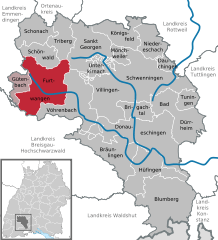Furtwangen im Schwarzwald
| Furtwangen im Schwarzwald | ||
|---|---|---|
| ||
 Furtwangen im Schwarzwald | ||
Location of Furtwangen im Schwarzwald within Schwarzwald-Baar-Kreis district 
 | ||
| Coordinates: 48°03′01″N 08°12′33″E / 48.05028°N 8.20917°ECoordinates: 48°03′01″N 08°12′33″E / 48.05028°N 8.20917°E | ||
| Country | Germany | |
| State | Baden-Württemberg | |
| Admin. region | Freiburg | |
| District | Schwarzwald-Baar-Kreis | |
| Government | ||
| • Mayor | Josef Herdner (CDU) | |
| Area | ||
| • Total | 82.57 km2 (31.88 sq mi) | |
| Population (2015-12-31)[1] | ||
| • Total | 9,091 | |
| • Density | 110/km2 (290/sq mi) | |
| Time zone | CET/CEST (UTC+1/+2) | |
| Postal codes | 78113–78120 | |
| Dialling codes | 07723 | |
| Vehicle registration | VS | |
| Website | www.furtwangen.de | |

Furtwangen im Schwarzwald is a small city located in the Black Forest region of south western Germany. It belongs to the district (Kreis) of Schwarzwald-Baar along with the two more important cities of Villingen and Schwenningen. The total population of Furtwangen was 9673 inhabitants on December 31, 2004. Furtwangen gained the right to call itself a city in 1873. The Breg is a small stream which, coming from the mountainous areas around Furtwangen, flows down through the inner city to the east. The Breg is one of the two little rivers which unite to form the river Danube.
Furtwangen is a city with an industrial past:
At one time Furtwangen was a major producer of clocks that were made and sold all over the world. While many different kinds of clocks were produced in Furtwangen, Furtwangen was unique for the production of musical clocks from the factory of Emilian Wehrle.
Emilian Wehrle (1832–1896) made musical clocks in the Furtwangen-Schönenbach area from about 1857 until his death in 1896. These musical clocks included the Trumpeter clock, Flute clock, Singing Bird Clock, and Rooster Clock. These clocks call the hour with the sound of the trumpet, flute, song bird and rooster respectively.
These clocks were the highest quality and were very expensive at the time. Because of this few were produced, and even fewer survived. Today collectors are after these musical pieces, and they continue to be sold at record prices.
This industry was very important in previous centuries, but with the appearance of the quartz watch this branch of the economy is now almost gone.
Today, Furtwangen is a city with a more balanced industry, there are many small and medium-sized industrial companies focused in microelectronics and precision mechanics. Among the cities in Germany Furtwangen one of those with the lowest unemployment rate.
There is a university of applied sciences. This university specialises in microelectronics, precision mechanics, computer sciences, informatics, digital media, industrial technologies, medical and life sciences, mechanical and medical engineering etc. Beside one of the university entrances is the Deutsches Uhrenmuseum (German Clock and Watch Museum) with many historical and modern clocks and watches on display. Tourists are often highly interested in visiting this museum.
Strongly frequented by traffic is the "B 500" road which is also commonly known as the black forest "Panoramastraße". In 1972, the railway connection called Bregtalbahn was closed after 80 years of service. The railway track had led from Furtwangen to Donaueschingen.
Sons and daughters of the city

- Hugo Eberhardt (1874-1959), architect
- Siegfried Weiss (1933-2013), cross-country skier
Personalities related to the city
- Christabel Bielenberg (1909-2003), British writer
- Robert Gerwig (1825-1885), engineer, from 1850 to 1857 head of watchmaking school
- Alexander Herr (born 1978), ski jumper
- Georg Hettich (born 1978), Nordic combiner
- Martin Schmitt (born 1978), popular ski jumper
- Thorsten Schmitt (born 1975), Nordic combiner
References
External links
![]() Media related to Furtwangen im Schwarzwald at Wikimedia Commons
Media related to Furtwangen im Schwarzwald at Wikimedia Commons
 Furtwangen
Furtwangen Furtwangen in January 2005 (in the mist)
Furtwangen in January 2005 (in the mist) University of Applied Sciences Furtwangen
University of Applied Sciences Furtwangen German Clock Museum
German Clock Museum
